https://www.beiltmachinery.com/Automatic-Vertical-Round-Bottle-Labeler-vs-Manual-Labeling.html
In an era where precision, efficiency, and speed are essential for competitiveness, packaging automation is no longer a luxury but a necessity. Labeling—an essential part of the packaging process—has seen a significant transformation, evolving from labor-intensive manual techniques to advanced automated solutions. Among these, the automatic vertical round bottle labeler stands out as a game-changer for businesses handling cylindrical containers. This article explores the differences between manual and automated labeling, with insights from Shanghai BEILT Machinery Equipment Co., Ltd., a trusted supplier in intelligent packaging solutions.
1. Labeling Accuracy and Consistency
Manual labeling heavily relies on human judgment, which can lead to misaligned, wrinkled, or uneven labels—especially when applied in high volumes or under time pressure. In contrast, automatic vertical round bottle labelers ensure precise and repeatable label placement. Using sensors, programmable logic controllers (PLCs), and stepper motors, these machines apply labels at exact positions, eliminating inconsistencies that could affect product presentation or barcode readability.
-
Manual Labeling: Accuracy varies based on operator skill and fatigue levels.
-
Automated Labeling: Delivers ±1mm accuracy with 100% repeatability across thousands of bottles.
2. Speed and Productivity
When it comes to output, the difference is dramatic. A trained operator might label 300–500 bottles per hour, depending on the complexity and fatigue. However, a BEILT automatic vertical round bottle labeler significantly increases throughput.
-
Manual Labeling: Labor-intensive; limited to small-batch production.
-
Automatic Labeling: Ideal for high-volume production; seamless integration into bottling lines.
3. Labor Costs and Operational Efficiency
As labor costs rise globally, businesses seek ways to optimize manpower. Manual labeling requires dedicated staff, ongoing training, and supervision. Automation reduces this dependency, allowing companies to reallocate human resources to more strategic tasks. Over time, automated systems lead to significant cost savings and return on investment (ROI).
-
Manual Labeling: High operational cost per unit; scalability limited.
-
Automatic Labeling: Low cost per label after setup; highly scalable and reliable.
4. Versatility and Customization
Shanghai BEILT’s machines are designed with versatility in mind. Their vertical round bottle labelers can accommodate a wide range of bottle sizes, label materials, and roll types. Additionally, optional features such as date coding, transparent label compatibility, or wrap-around label modules provide further customization.
-
Manual Labeling: Limited adaptability to label shapes or bottle sizes.
-
Automated Labeling: Easily adjustable with modular add-ons and digital calibration.
5. Error Reduction and Waste Minimization
Errors such as misapplied or damaged labels result in product waste and additional labor. Manual processes are prone to such issues, especially over extended periods. Automated systems include label sensors, bottle detectors, and real-time error alerts, which dramatically reduce waste and improve overall yield.
-
Manual Labeling: Prone to human error; waste due to label misalignment or rework.
-
Automatic Labeling: Built-in safety features reduce errors; higher first-pass yield.
6. Compliance and Traceability
Industries such as pharmaceuticals, cosmetics, and food and beverage must adhere to stringent labeling regulations. Automated systems ensure regulatory compliance with consistent barcode placement, batch coding, and serialization. Manual labeling falls short in meeting such traceability demands, especially at scale.
-
Manual Labeling: Difficult to meet traceability and uniformity standards.
-
Automated Labeling: Supports digital coding and traceable production records.
7. Initial Investment vs. Long-Term Gains
While manual labeling appears cheaper upfront, it incurs ongoing labor and quality control costs. In contrast, Shanghai BEILT’s labeling systems require a one-time investment but offer long-term operational efficiency and quality control. Their vertical round bottle labelers are engineered for durability, minimal maintenance, and user-friendly operation.
-
Manual Labeling: Low initial cost; high cumulative cost over time.
-
Automated Labeling: Higher upfront investment; long-term savings and performance benefits
https://www.beiltmachinery.com/Packaging-with-the-Automatic-Vertical-Round-Bottle-Labeler.html
www.beiltmachinery.com
Shanghai BEILT Machinery Equipment Co., Ltd.




More Stories
Maximizing Efficiency and Precision with Horizontal Machining Centers
Mini Single Screw Extruder: Precision Engineering and High-Performance Application Guide
How a laser wire marking machine Enhances Identification Accuracy in Modern Cable Manufacturing